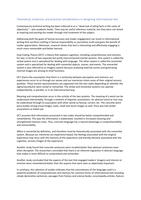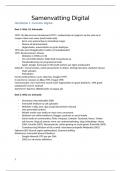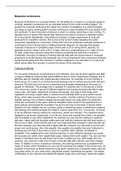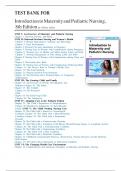Theoretical, empirical, and practical considerations in designing informational text
Contemporary technical writing has been referred to as a ‘’dead task of piling facts in the name of
objectivity’’ – also academic books. They may be useful reference material, but they were not aimed
at inspiring and exciting the reader through vital treatment of the subject.
Addressing both the goals of factual accuracy and reader engagement can result in informational
writing that sacrifices nothing in factual responsibility or journalistic truth and gains the benefit of
reader appreciation. Moreover, research shows that text is interesting and affectively engaging is
much more memorable and better learned.
Dual Coding Theory (DCT): a theory that explains cognition, including comprehension and memory
for text, in terms of two separate but partly interconnected mental systems. One system is called the
verbal system and is specialized for dealing with language. The other system is called the nonverbal
system and is specialized for dealing with nonverbal objects, scenes, and events. The nonverbal
system is also referred to as imagery system because analyzing external scenes and generating
internal images are among its chief functions.
DCT shares the assumption that there is a continuity between perception and memory: our
experiences occur to us through our senses and our memories retain some of their original sensory
qualities. These mental representations are organized into the two codes depending on whether the
sights/sounds/etc were verbal or nonverbal. The verbal and nonverbal systems can operate
independently, in parallel, or in an interconnected way.
Meaning and comprehension occur in the activity of the two systems. The meaning of a word can be
understood interverbally, through a network of linguistic associations. An abstract word as true may
be understood through its association with other words as factual, correct, etc. The concrete word
pizza evokes strong visual images, taste, smell and touch images as well. Pizza also had verbal
associations as Italian pie.
DCT assumes that information processed in two codes should be better comprehended and
remembered. This way the information is elaborated, resulted in increased meaning and
strengthened memory trace. Thus, concrete language has a natural advantage in comprehensibility
and memorability.
Affect is nonverbal by definition, and therefore must be theoretically associated with the nonverbal
system. Because our memories are experience based, the feelings associated with the original
experience may recur with the memory of the experience and thereby become associated with the
cognitive, sensory images of the experience.
Another study found that concrete sentences were recalled better than abstract sentences even
when disrupted. The researchers concluded that there is an inherent vagueness in abstract language
that makes it more difficult to comprehend and remember.
Another study concluded that the aspects of the text that engaged readers’ imagery and interest or
emotion were remembered better than the aspects that were seen as objectively important.
In summary, this selection of studies indicates that the concreteness of the language used is a
powerful predictor of comprehension and memory for common forms of informational text including
simple declarative sentences, passages from history and science books, encyclopedia articles, feature
Contemporary technical writing has been referred to as a ‘’dead task of piling facts in the name of
objectivity’’ – also academic books. They may be useful reference material, but they were not aimed
at inspiring and exciting the reader through vital treatment of the subject.
Addressing both the goals of factual accuracy and reader engagement can result in informational
writing that sacrifices nothing in factual responsibility or journalistic truth and gains the benefit of
reader appreciation. Moreover, research shows that text is interesting and affectively engaging is
much more memorable and better learned.
Dual Coding Theory (DCT): a theory that explains cognition, including comprehension and memory
for text, in terms of two separate but partly interconnected mental systems. One system is called the
verbal system and is specialized for dealing with language. The other system is called the nonverbal
system and is specialized for dealing with nonverbal objects, scenes, and events. The nonverbal
system is also referred to as imagery system because analyzing external scenes and generating
internal images are among its chief functions.
DCT shares the assumption that there is a continuity between perception and memory: our
experiences occur to us through our senses and our memories retain some of their original sensory
qualities. These mental representations are organized into the two codes depending on whether the
sights/sounds/etc were verbal or nonverbal. The verbal and nonverbal systems can operate
independently, in parallel, or in an interconnected way.
Meaning and comprehension occur in the activity of the two systems. The meaning of a word can be
understood interverbally, through a network of linguistic associations. An abstract word as true may
be understood through its association with other words as factual, correct, etc. The concrete word
pizza evokes strong visual images, taste, smell and touch images as well. Pizza also had verbal
associations as Italian pie.
DCT assumes that information processed in two codes should be better comprehended and
remembered. This way the information is elaborated, resulted in increased meaning and
strengthened memory trace. Thus, concrete language has a natural advantage in comprehensibility
and memorability.
Affect is nonverbal by definition, and therefore must be theoretically associated with the nonverbal
system. Because our memories are experience based, the feelings associated with the original
experience may recur with the memory of the experience and thereby become associated with the
cognitive, sensory images of the experience.
Another study found that concrete sentences were recalled better than abstract sentences even
when disrupted. The researchers concluded that there is an inherent vagueness in abstract language
that makes it more difficult to comprehend and remember.
Another study concluded that the aspects of the text that engaged readers’ imagery and interest or
emotion were remembered better than the aspects that were seen as objectively important.
In summary, this selection of studies indicates that the concreteness of the language used is a
powerful predictor of comprehension and memory for common forms of informational text including
simple declarative sentences, passages from history and science books, encyclopedia articles, feature







